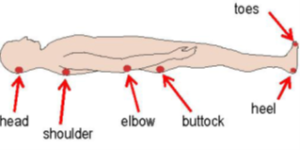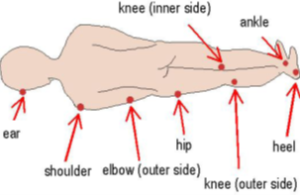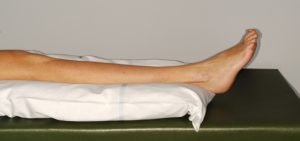Tissue Viability (community)
Pressure ulcers – a guide for patients and carers
Patient Information Leaflet
This information is provided by The Dudley Group NHS Foundation Trust along with recommendations made by the National Institute for Clinical Excellence. It is aimed at people, and carers of people, who are at risk of developing pressure ulcers.
Explanation of terms used in this booklet
Healthcare professional
In this booklet, we use the term healthcare professional to mean anyone working as part of your healthcare team. For example, this could be your doctor, nurse, care support worker, physiotherapist or occupational therapist.
Carers
People may be cared for by a relative or a friend when they are ill, while others may have paid care workers to look after them. In this booklet, the term carer means unpaid carers such as friends or relatives, not paid care workers.
Pressure ulcers
Pressure ulcers may also be called bed sores or pressure sores.
What is a pressure ulcer?
A pressure ulcer is damage that occurs on the skin and underlying tissue. Pressure ulcers are caused by two main things:
- Pressure – the weight of the body pressing down on the skin.
- Shear – the layers of the skin are forced to slide over one another or over deeper tissues, for example when you slide down or are pulled up a bed chair, or when you are transferring to and from your wheelchair.
The first sign that a pressure ulcer may be forming is usually discoloured skin, which may get progressively worse and eventually lead to an open wound.
Where can pressure ulcers develop?
The most common places for pressure ulcers to develop are over bony prominences (bones close to the skin). Some of the most common sites are shown below:


Illustration kindly used with permission from Family and Elderly Health Services, Department of Health, Hong Kong.
Who gets pressure ulcers?
Anyone can get a pressure ulcer, but some people are more likely to develop one than others. People with a pressure ulcer are also at risk of developing another elsewhere on their body.
You are more at risk of getting a pressure ulcer if you:
- Have problems moving and cannot change position by yourself without help.
- Cannot feel pain over a part or all of your body.
- Are incontinent.
- Are seriously ill or undergoing surgery.
- Have had pressure ulcers in the past.
- Have a poor diet and do not drink enough water.
- Are very old or very young.
- Have damaged your spinal cord and can neither move nor feel your bottom and legs.
- Have heart problems or poor circulation.
Preventing pressure ulcers
Pressure ulcers can develop very quickly in some people if the person is unable to move for even a very short time – sometimes within an hour.
Keep moving
One of the best ways of preventing a pressure ulcer is to reduce or relieve pressure on areas that are vulnerable to damage (see the diagrams on page 2). This is done by moving around and changing position as much as possible.
If possible, change your position at least every two hours; alternate between your back and sides. If you already have a pressure ulcer, lying or sitting on the ulcer should be avoided as it will make the ulcer worse.
People with limited mobility may need to have assistance to change their position by a healthcare professional or carer.
Use pillows to lift your heels off the bed, or to stop your ankles and knees touching each other, especially when you are lying on your side.

You may need a special mattress, or seat cushion. Your healthcare professional can advise you on what will be suitable for your needs.
Skin assessment
Your skin should be assessed regularly to check for signs of pressure ulcer development. How often your skin is checked depends on your level of risk and your general health. You or your carer should inspect your own skin for signs of pressure damage – you might need help to look at awkward areas such as your bottom or heels.
What should you be looking for?
- Be mindful of different skin tones. In light toned skin, you might notice a red area that does not disappear.
- In darker toned skin, you might notice a purple / bluish area. Touch should be considered in darker toned skin to identify any heat or swelling over bony prominences.
- Blisters or damage to the skin.
- Patches of hot skin.
- Patches of hard skin.
- Patches of cool skin.
If you or your carers notice possible signs of damage, you should tell someone in your healthcare team immediately.
A good diet
Eating well and drinking enough water is very important. It is particularly important for people at risk of developing a pressure ulcer or those with a pressure ulcer. If you already have an ulcer, your body will require extra calories to heal. Eating foods high in calories and protein, such as cheese, fish, meat and eggs can help.
If you do have a pressure ulcer, your healthcare professional may refer you to a dietitian for specialist advice.
Treating pressure ulcers
Your pressure ulcer may need a dressing to help it heal. Your healthcare professional will discuss this with you, advising you on the most suitable dressing for your ulcer.
If you have signs of infection, your healthcare professional may treat it with antibiotics or special dressings that kill bacteria.
Sometimes, other treatments may be needed. These treatments include:
- Negative pressure therapy, where suction is applied to the wound.
- Maggot therapy, where maggots are applied to the wound bed to remove dead tissue.
- Sharp debridement, where a blade is used to remove dead tissue.
Further information
For further information regarding our services, contact Tissue Viability:
Telephone: 01384 456111 extension 3368
Direct number: 01384 244368
Email: tviability@nhs.net
Resources
If you have any questions, or if there is anything you do not understand, please contact the Russells Hall Hospital switchboard number on 01384 456111 and ask for the relevant department who issued this leaflet.
If you have any feedback on this patient information leaflet please email dgft.patient.information@nhs.net
This leaflet can be made available in large print, audio version and in other languages, please call 0800 073 0510.
Originator: Tissue Viability Team. Date originated: October 2024. Review date: October 2027. Version: 2. DGH ref.: DGH/PIL/02161.
